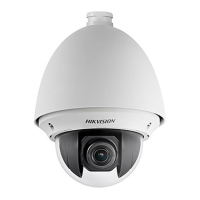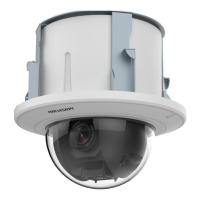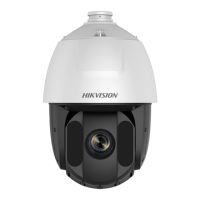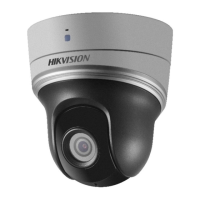
Do you have a question about the HIKVISION DS-2DE4425IW-DE and is the answer not in the manual?
| Type | IP security camera |
|---|---|
| PTZ modes | 4 Pattern |
| PTZ control | Yes |
| Placement supported | Indoor & outdoor |
| Connectivity technology | Wired |
| Maximum operating distance | 1.5 m |
| Audio input channels | 1 channels |
| Audio formats supported | G.711, G.722.1, G.726, MP2L2, PCM |
| Wi-Fi | - |
| Number of users | 32 user(s) |
| Streaming method | Multicast |
| Cabling technology | 10/100Base-T(X) |
| Networking standards | IEEE 802.1x, IEEE 802.3at |
| Ethernet interface type | Fast Ethernet |
| Supported network protocols | IPv4/IPv6, HTTP, HTTPS, 802.1x, Qos, FTP, SMTP, UPnP, SNMP, DNS, DDNS, NTP, RTSP, RTCP, RTP, TCP, UDP, IGMP, ICMP, DHCP, PPPoE, Bonjour |
| Compatible memory cards | MicroSD (TransFlash), MicroSDHC, MicroSDXC |
| Maximum memory card size | 256 GB |
| Ethernet LAN (RJ-45) ports | 1 |
| Form factor | Dome |
| Mounting type | Ceiling/wall |
| Product color | Black, White |
| International Protection (IP) code | IP66 |
| Pan range | 0 - 360 ° |
| White balance | ATW, Auto, Fluorescent, Indoor, Manual, Outdoor, Sodium lamp |
| Pan preset speed | 80 °/sec |
| Tilt angle range | -15 - 90 ° |
| Camera shutter speed | 1/1 - 1/30000 s |
| Minimum illumination | 0 lx |
| Preset programs quantity | 300 |
| Intelligent Video Surveillance (IVS) system features | Abandoned object, Crossing line, Intrusion, Missing object |
| Sensor type | CMOS |
| Optical sensor size | 1/2.5 \ |
| Behavior analysis | Intrusion detection, Line crossing detection |
| Focus | Motorized/Manual |
| Digital zoom | 16 x |
| Optical zoom | 25 x |
| Focal length range | - mm |
| Maximum aperture number | 3.5 |
| Minimum aperture number | 1.6 |
| DC output voltage | 12 |
| Power source type | DC |
| Power consumption (max) | 18 W |
| Operating temperature (T-T) | -30 - 65 °C |
| Operating relative humidity (H-H) | 0 - 90 % |
| LED type | IR |
| Night vision distance | 100 m |
| Total megapixels | 4 MP |
| Gain control type | Auto/Manual |
| Maximum resolution | 2560 x 1440 pixels |
| Video compression formats | H.264, H.264+, H.265, H.265+, M-JPEG |
| Noise reduction technology | 3D noise reduction |
| Analog signal format system | NTSC, PAL |
| Number of simultaneous users | 20 user(s) |
| Height | 290 mm |
|---|---|
| Weight | 2450 g |
| Diameter | 164.5 mm |
Specifies hardware and software requirements for web browser access.
Details core camera functions including PTZ, scanning, presets, and image controls.
Instructions for connecting and configuring the camera on a Local Area Network.
Explains the two ways of cable connection for network camera and computer.
Guides on activating the camera via web browser, SADP software, or client software.
Optional step to set security questions for password recovery.
Instructions for connecting and configuring the camera on a Wide Area Network.
Details connecting the camera to the WAN using a static IP address.
Explains connecting the camera to the WAN using a dynamic IP address.
Step-by-step guide to access the camera using a web browser.
Instructions for managing the camera using the provided client software.
Describes the self-test actions performed by the speed dome upon power-up.
Guides on setting live view and operation parameters via the web browser.
Operations for viewing live video, controlling PTZ, and managing presets/patrols.
How to play back, download video files, and manage captured images.
Configure settings for storing recorded video and captured images.
Set up schedules for continuous or event-triggered video recording.
Configure schedules for taking snapshots or event-triggered captures.
Steps to add and configure a Network Attached Storage (NAS) device.
Configure how the camera responds to various events like motion or alarms.
Set up motion detection to trigger alarms and record video.
Configure detection for when the camera lens is covered or tampered with.
Configure settings for external alarm inputs connected to the camera.
Set up actions for alarm outputs, like activating external devices.
Configure responses to system exceptions like HDD full or network disconnection.
Configure advanced intelligent video analysis events.
Configure detection for audio anomalies like loss or sudden sound changes.
Set up the camera to detect and react to faces in the video stream.
Configure detection zones to trigger alarms when objects enter or cross them.
Set up virtual lines to detect objects crossing in a specified direction.
Detect objects entering a predefined virtual region.
Detect objects exiting a predefined virtual region.
Detect baggage left unattended in a predefined virtual region.
Detect objects removed from a predefined virtual region.
Configure the Pan, Tilt, and Zoom (PTZ) functions of the speed dome.
Set fundamental PTZ parameters like proportional pan, preset freezing, and speed.
Define the operational movement limits for the camera's pan, tilt, and zoom.
Set or customize the camera's starting position after power-up or reset.
Define automatic PTZ actions to perform after a period of inactivity.
Mask specific areas of the video feed to protect privacy.
Schedule automatic PTZ actions or camera operations at specific times.
Enable automatic tracking of moving objects within the camera's view.
Enable faster focusing by using calibration data.
Configure network parameters like TCP/IP, DDNS, and PPPoE.
Set up TCP/IP, DNS, DDNS, and PPPoE for fundamental network operation.
Configure SNMP, FTP, Email, HTTPS, QoS, 802.1X, and Integration Protocols.
Configure video stream, audio input/output, and Region of Interest (ROI) settings.
Adjust video stream parameters like resolution, bitrate, encoding, and frame rate.
Configure audio encoding, input, bitrate, and volume settings.
Enhance image quality in specific regions of interest using Fixed or Dynamic ROI.
Configure display of object information on the video stream.
Adjust display, image enhancement, video, OSD, and text overlay parameters.
Configure image adjustment, exposure, focus, day/night, backlight, and white balance.
Apply noise reduction, defogging, stabilization, and mirror functions.
Configure mirror function, video standard, and capture mode.
Configure on-screen display of camera name, time, and date.
Customize text overlays on the video stream.
Set up scene switching based on time or linked presets.
View device information and configure time, date, and DST settings.
View device details and configure time zone, NTP sync, and DST.
Manage camera settings, reboot, restore defaults, and upgrade firmware.
Search logs and configure remote connection and system service settings.
Secure the camera through authentication and IP address filtering.
Manage user accounts, permissions, and online user status.











